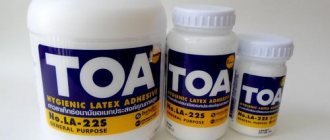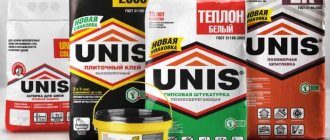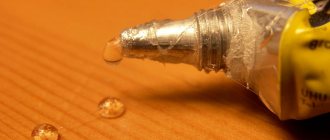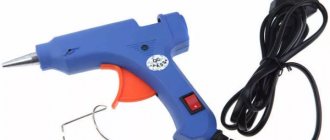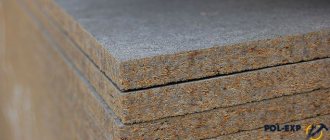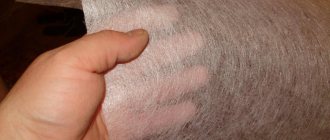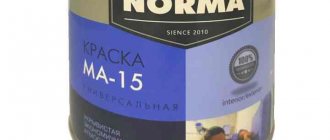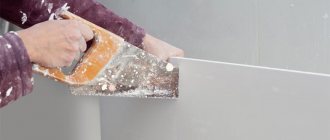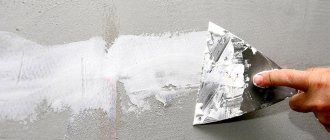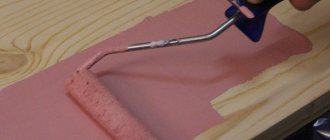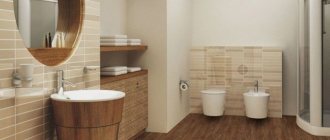Epoxy glue-plasticine - instructions for use
If we talk about epoxy resin, then it is part of various adhesives. Some of them have a liquid texture, others are more viscous and dense. Epoxy glue-plasticine can be considered a unique product - a reliable, high-strength material for bonding various surfaces.
The epoxy composition provided the basis for the creation of glue-plasticine called “Contact”, which is also called cold welding. In appearance, it is a plastic mass of grayish color, which is used for gluing various materials.
Unlike hot welding, cold welding does not involve the use of high temperatures. An excellent level of adhesion and strong adhesion will be ensured by the adhesive entering the upper layers of the parts, melting them and firmly adhering to each other.
Epoxy plasticine - what is it?
Epoxy clay is more like cold welding than glue, but it is safe and easier to work with. Plasticine is easy to knead in your hands and has excellent ductility and adhesion. This is not a sealant - you can read what a sealant is here.
If plasticine is used in accordance with the instructions, the connection is very strong, almost as strong as metal. Moreover, the composition of plasticine is non-toxic and does not emit harmful fumes.
Contact glue, brand information
Before understanding the manufacturer's products, it is necessary to talk about the brand itself. The first glue from the Contact company appeared on the market in 2002. Adhesive compositions quickly gained popularity among buyers due to their characteristics.
Initially, the brand produced its products together with the manufacturer “Tong Shen”. Today, it is a separate organization that supplies its products to 36 countries around the world. The main factories that manufacture products are located in Southeast Asia. Epoxy composition “Contact” is considered one of the best adhesives in the CIS countries.
Epoxy glue-plasticine how to use and scope of application
Epoxy glue has a fairly wide range of applications:
- Decorative modeling, modeling of figures, small parts. Plasticine remains plastic for a long time, and after hardening the product can be processed mechanically and painted. Dolls, small figurines, costume jewelry are made from plasticine, and for repairing products made of earthenware, porcelain, wood, plastic, and metal.
- When doing plumbing work, plasticine is excellent for sealing cracks in pipes and sealing joints. Epoxy plasticine is not afraid of temperature changes and works at temperatures from -40 to +120 degrees Celsius.
- Epoxy plasticine is waterproof, so it is used in the repair of boats, swimming pools, and car repairs.
Advantages and disadvantages of use
The use of cold welding is becoming more and more common due to the fact that this composition has a large number of advantages in terms of use. And glue-plasticine “Contact” is no exception. The main advantages of this adhesive include:
- ease of use . No special skills are needed to carry out repairs using this composition, since to obtain a high-quality connection you only need to follow the instructions for use;
- the ability to quickly repair the product or connect elements , which will allow you to start using such a product in a short time;
- carrying out repairs even in hard-to-reach places due to the absence of the need to use complex equipment;
- making connections and repairs without using high temperatures while simultaneously obtaining a seam that is resistant to excessively high and low temperatures;
- obtaining a strong connection due to the characteristics of the chemical composition , which makes it possible to melt the upper layers of the material from which the product is made, followed by penetration into these layers and hardening;
- the possibility of restoring the shape of a repaired product , as well as filling possible voids in such a product, which also affects the increase in the strength of the composition;
- in the case of using a waterproof adhesive composition, it is possible to seal the joints in the connection (especially important in the case of elements of the heating system, as well as elements of the water supply system). Also, waterproof compositions of Contact glue-plasticine are characterized by resistance to various chemical compounds, for example, technical oils and liquids;
- the possibility of mechanical processing of adhesive joints after complete polymerization of the composition itself.
If we talk about the shortcomings, they are presented as follows:
- impossibility of repairing products made of Teflon, silicone, polyethylene (since the glue does not work with these chemical compositions);
- difficult to remove due to high strength in case of incorrect use or application of excess fragments . If it has been determined that the composition was applied incorrectly, it must be removed before complete polymerization.
Popular brands of epoxy plasticine
- Adhesive plasticine "Modelite". This is a two-component glue-plasticine intended for decorative crafts.
The consistency is of moderate viscosity, the composition remains soft for 1.5-3 hours, hardens after 24 hours. Plasticine does not crack after hardening, can be machined, and can be painted.
- Glue-plasticine “Contact”. One of the most popular, made in China. Designed for sealing leaks in pipes, under water. The one-component composition is kneaded with your fingers for 2-3 minutes, and the plasticine is ready for use. The tightness of the connection is achieved in 5-7 minutes; you can work with plastic, metal, glass and wood, as well as stone and brick.
Epoxy composition "Contact"
Areas of use
When working with plasticine, you should strictly follow the rules of application and pre-prepared surface. If everything is done correctly, the product will give a connection no less strong than the metal itself.
If the preparatory work is done poorly, the joint will be weaker and will not last long. The areas of application of epoxy type plasticine mass are:
Construction, gluing of reinforced concrete, concrete, wooden products, as well as for filling cracks and fastening tiles.- Attaching solar batteries.
- Repair work of boats, cars and boats.
- Housekeeping – restoration of souvenirs, shoes and furniture.
Please note that epoxy adhesive has many advantages. The resulting seam is waterproof, elastic, resistant to chemicals, low and high temperatures.
The disadvantages include the inability to bond polyethylene, Teflon and silicone. Another disadvantage is the difficulty of removing the product - it will harden quickly and will be difficult to remove due to its high degree of strength.
Types of product
There are a couple of types of glue-plasticine on sale, and they can be used for gluing things and various objects at a construction site, at home, and also in industry. Epoxy waterproof plasticine was created for repair work in conditions of high humidity, as well as for repairing pipes and eliminating various leaks. The product can even glue cracks and other flaws under water. The waterproof material is two-component and contains a hardener and polyepoxy resin. Here are its main properties:
- Excellent restoration of the shape of objects, as well as filling voids.
- Possibility to seal joints.
- Resistance to household pollution, fats, liquids and technical oils.
- Long service life.
- Possibility of mechanical processing of the adhesive seam.
After the glue has hardened, you can operate it at temperatures of -42...+150 degrees, and this will not lead to destruction, cracking, or crumbling of the gluing areas. Using this product is very convenient - you can simply knead it with your fingers. There is another type of adhesive on sale - this is epoxy adhesive-plasticine “Cold Welding”.
Composition of the adhesive
In addition to epoxy resin, such a product also contains binding additives, modifiers and plasticizers. Polymercaptan acts as a hardener - it is a low molecular weight polymer.
Bonded materials
Products from the epoxy type plasticine series are perfect for gluing cardboard, plastic, metals and alloys (stainless steel, aluminum, tin, iron, bronze and others). They can also glue the following materials: fiberglass, fiberglass, glass, ceramics, porcelain, earthenware, ceramics, wood, stone, polyvinyl chloride, concrete, stone, reinforced concrete and bricks.
Instructions for use
Before starting work, you should carefully prepare both parts to be glued. They should be completely cleaned of dirt, dust, and also degreased. To do this, you can use alcohol - medical, technical, and acetone will also work. For glass, ceramics and other suitable materials, use the simplest detergents. Next, you should completely dry the treated surface. When gluing metal products, or those made of alloys or stainless steel, they should be pre-treated with sandpaper. You can also use other methods to roughen the surface. The procedure for working with epoxy plasticine is as follows:
Separate the required amount of the composition. It cannot be broken off manually, because this can lead to incorrect measurements of the adhesive composition and the dosage of resin and hardener, which will also become incorrect. Cut the plates with a sharp knife.- Knead the mixture in your hands until it is completely mixed. Hands should be wet and gloves should be put on beforehand. The mixing time is 2 minutes, and the mass will eventually become homogeneous.
- Apply the product to a previously prepared surface that needs to be restored or even repaired. Give the base the desired shape and seal defects. If two parts are glued together, they should be pressed against each other for 6 minutes. If repair work will be carried out under water, then the plasticine should be smoothed until the flow stops.
It also happens that repair work is carried out in conditions of cold water or air temperatures. In such a situation, plasticine may not be flexible enough and may not knead well. It is better to put the tube in a container with hot water (+65 degrees) for 5 minutes or keep it on hot radiators. You should work with the adhesive composition faster from the moment of mixing, and its pot life is from 3 to 5 minutes. During the prescribed time, you should have time to adjust the shape of the plasticine and the placement of parts.
Please note that after just an hour you can drill, sharpen, paint and clean the seams if the craftsman needs it. The material will be ready for full use, resistant to water, solvents and oils.
Precautionary measures
The epoxy-type composition should be kept away from children and animals; it should only be stored out of their reach. When working, be sure to wear gloves. If it comes into contact with the skin, it should be washed immediately with soap and water. Contact of the composition with the eyes, which causes allergic reactions, severe irritation from the composition on the skin, are indications for contacting a doctor, and plasticine should not be used for products that will come into contact with food.
Glue plasticine - how to use
On each package of epoxy plasticine you can find instructions for use, and it is recommended to follow them, since each composition may have different recommendations for use. However, for all types there are general recommendations on how to use:
- First of all, it is necessary to thoroughly clean the surfaces to be joined or the surface on which the plasticine will be applied. First, if necessary, clean with sandpaper, rinse with water, then degrease with acetone or alcohol, and dry.
- Using a blade, we separate the required amount of the composition from the “sausage” of plasticine, knead it in our hands until it reaches the desired viscosity, usually this happens within 2-3 minutes.
- Apply plasticine to the surfaces to be joined and fix tightly for 5-7 minutes. After 2-3 hours the part can be used, but you need to remember that the plasticine gains full hardness within 24 hours.
Instructions for use
Before work, it is important to carefully prepare both parts to be glued. They must be completely cleaned of dust, dirt, and degreased. For this purpose, you can use alcohol - technical, medical, acetone is also suitable. For ceramics, glass and other suitable materials, use ordinary detergents. Next, you need to completely dry the surface. When gluing products made of metal, stainless steel or alloys, they are pre-treated with sandpaper. You can use another method to roughen the surface.
The procedure for working with epoxy plasticine is as follows:
- Separate the required amount of product. It should not be broken off by hand, since this can cause the glue to be measured incorrectly, and the dosages of resin and hardener will also be incorrect. Cut off the plasticine with a sharp knife.
- Knead the product in your hands until it is mixed. Hands should be wet and gloves should be put on them in advance. The mixing time is 2 minutes, the mass eventually becomes homogeneous.
- Apply the product to the prepared surface that needs to be restored or repaired. Give the base the desired shape and repair the defect. If two parts are glued together, they are pressed against each other for 5 minutes. If the repair is carried out under water, then smooth the plasticine until the leak stops.
It happens that repairs are carried out in conditions of cold air or water temperatures. In such a situation, plasticine is not flexible enough and does not knead well. It is better to put the tube in a container with hot water (60 degrees) for 5 minutes or keep it on a hot radiator. You need to work with glue faster from the moment of mixing; its pot life is 3-5 minutes. During the specified time, you need to have time to adjust the shape of the plasticine and the location of the parts.
After just an hour, it is possible to drill, sharpen, paint and clean the seam area, if required by the craftsman. The material is ready for full use, resistant to water, oils and solvents.
Buy sculpture plasticine
In the online store
(pickup in Moscow, delivery throughout Russia) you can buy sculptural plasticine of any hardness (Soft, Medium or Hard) and at a competitive price.
To do this, select sculptural plasticine with the desired characteristics from among the products, add it to your cart and place your order. We will be happy to constantly cooperate with our store, so we have provided a personal account for you on the website. Pay attention to related products
, such as cleaner, solvent and tools: it is convenient and profitable to buy everything you need in one place.
Delivery
sculptural plasticine
in Moscow
is carried out using a courier service, and you can also receive it yourself during warehouse opening hours. You can pay for your order in cash to the courier after delivery of the goods, or upon receipt of it at the warehouse.
If you are outside the capital
, select the delivery option using transport or “Business lines”. In this case, payment will be made by bank transfer according to the invoice.
Characteristics of the solution
Epoxy glue can be one- or two-component. Its composition usually includes epoxy resins, which impart plasticity to the solution, metal components and auxiliary substances. The strength of cold welding will depend on how accurately the work was carried out, as well as on the correct preparation of the surface. Under ideal conditions, it will be possible to obtain a very strong connection, even stronger than the metal itself. But if the work is not carried out correctly, the connection will turn out to be very flimsy.
Adhesive plasticine is universal and is used in many areas of life:
- in construction, for connecting reinforced concrete structures, filling cracks in concrete and gluing tiles;
- in aircraft design;
- when creating solar panels;
- in mechanical engineering, for fastening brake pads, connecting metal surfaces with plastic parts, etc.;
- in shipbuilding;
- in the household, for gluing shoes, furniture, when creating souvenirs.
Unique material
What is Sugru? This is a unique material that not only allows you to reliably glue individual elements, but also modify objects at your own request. In appearance, the material is similar to plasticine, which after hardening becomes very dense. You can use it in almost any way: gluing fallen handles from pots and pans, repairing shoes, making protective pads, sealing joints, etc. Sugru can be used to glue wood, metal, ceramics, glass, plastic and fabric.
How to make smart plasticine?
Many people remember smart plasticine or slime. It was a material that could take almost any shape. Today, slime has transformed into handgam, which you can easily make with your own hands at home. How to make smart plasticine from PVA glue? To do this, you need to prepare approximately 100 g of PVA, food coloring of your choice, as well as half a bottle of sodium tetraborate, which can be purchased at any pharmacy. To obtain plasticine from PVA, all components must be thoroughly mixed in a glass container, while protecting your hands with gloves.
